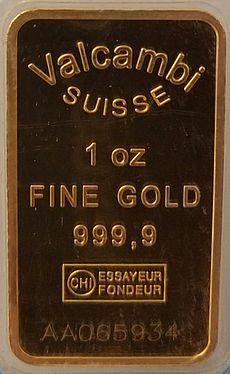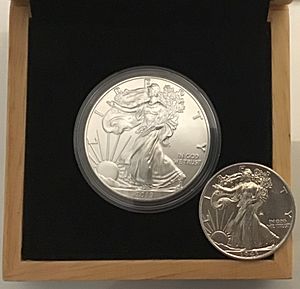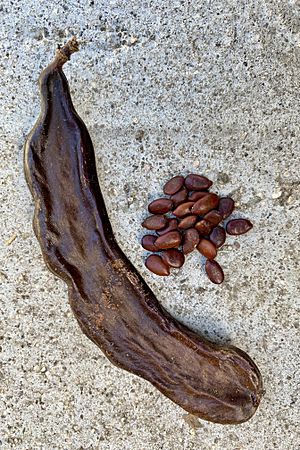Carat (purity) facts for kids
When we talk about the fineness of a precious metal object, like a coin, a gold bar, or a piece of jewelry, we mean how much pure metal it contains. It's the weight of the pure metal compared to the total weight of the object.
Objects made from precious metals often have other metals mixed in. These are called alloys. For example, copper is often added to silver to make it stronger. This is because pure precious metals can be very soft. Adding other metals makes them harder and more durable for things like coins and jewelry. It can also change their color or make them less expensive to produce.
For example, old silver coins in the past were often "coin silver." This meant they were 90% silver and 10% copper. Sterling silver, which is popular for jewelry, is 92.5% silver and 7.5% other metals, usually copper.
There are two main ways to describe fineness:
- Millesimal fineness: This uses "parts per 1,000."
- Karats: This is only used for gold and measures parts per 24.
Contents
Millesimal Fineness: Parts Per 1,000
Millesimal fineness tells us how pure a platinum, gold, or silver alloy is by showing how many parts out of 1,000 are pure metal. For example, if an alloy is 75% gold, its millesimal fineness is "750."
Many countries in Europe use these numbers as official stamps (like "585" or "750") on jewelry. This is different from how the United Kingdom and United States often use "14 k" or "18 k" for gold.
This system is like an updated version of the older karat system. The millesimal fineness number is usually rounded to three digits.
Here are some common millesimal fineness numbers for precious metals:
Platinum Purity
- 99.95: This is almost 100% pure. It's very common for platinum coins and bars.
- 999: Also called three nines fine.
- 950: This is the most common purity for platinum jewelry.
- 900: One nine fine.
- 850
- 750
Gold Purity
- 999.999: This is the purest gold ever made! It was refined by the Perth Mint in 1957.
- 999.99: This is the purest gold made today. The Royal Canadian Mint makes special coins with this fineness.
- 999.9: This is very popular. You'll find it in coins like the Canadian Gold Maple Leaf.
- 999: This is considered 24 karat gold. You can find it in Chinese Gold Panda coins.
- 995: This is the minimum purity for large gold bars used in trading.
- 916: This is 22 karat gold. It has been used for many famous gold coins, like the British Sovereigns and South African Krugerrands.
- 900: This was used for many old American gold coins and coins from the Latin Monetary Union.
- 750: This is 18 karat gold. It's very common for jewelry.
- 585: This is 14 karat gold.
- 417: This is 10 karat gold.
- 375: This is 9 karat gold. It's the lowest standard for gold in places like Australia, Canada, and the UK.
- 333: This is 8 karat gold. It's the lowest standard in Germany since 1884.
- 1 karat: This is the lowest legal gold purity in the US since 2018.
Silver Purity
- 999.99: The purest silver ever made, by the Royal Silver Company of Bolivia.
- 999.9: Very pure silver, used by the Royal Canadian Mint for their Silver Maple Leaf coins.
- 999: This is called fine silver or three nines fine. It's used in most modern silver bullion coins and large silver bars.
- 958: This is Britannia silver.
- 950: This is the French 1st Standard.
- 925: This is Sterling silver. The UK has used this alloy for centuries. It's very common for jewelry and silverware.
- 900: This is coin-silver or 90% silver. Many old US silver coins were made with this purity.
- 800: This is a common standard in Germany and France.
- 500: This was used for British coins from 1920 to 1946.
- 400: This was used for US half dollars between 1965 and 1970.
- 350: This was used for US Jefferson "war nickels" during World War II (1942-1945).
Karat System for Gold
The karat (or carat in the UK) system is used only for gold alloys. It tells us how many parts out of 24 are pure gold. For example, 18-karat gold means 18 parts are pure gold and 6 parts are other metals.
- 24-karat gold is considered pure gold (at least 99.95% pure).
- 18-karat gold is 18 parts gold and 6 parts other metals. This means it's 75% gold.
- 12-karat gold is 12 parts gold and 12 parts other metals. This means it's 50% gold.
The karat system is still widely used for jewelry, but the millesimal system is becoming more common, especially for gold bars.
Gold by Mass vs. Volume
The karat system usually talks about the mass (weight) of pure gold in an alloy. But the amount of gold by volume can be different. This is because gold is much heavier (denser) than most other metals.
For example, 18-karat yellow gold is 75% gold by mass. But because gold is so dense, the pure gold might only take up about 60% of the total volume of the alloy.
Where Did "Karat" Come From?
The word "karat" comes from the word "carat." It first appeared in English in the 1400s. It came from an old French word, which came from an Italian or Latin word. These words were borrowed from the Arabic word qīrāṭ, which meant "fruit of the carob tree" or "weight of 5 grains."
The Arabic word itself came from the Greek word kerátion, which means "carob seed." Carob seeds were once used as small weights because they were thought to be very consistent in size.
Around 309 CE, the Roman Emperor Constantine I started making a new gold coin called the solidus. This coin weighed 1/72 of a Roman pound of gold, which was equal to 24 siliquae. Each siliqua was also called a "carat." This is believed to be how the number 24 became linked to the karat system for gold purity.
Checking Fineness
How do we know if a precious metal object is as pure as it says it is? There are two main ways to check:
- Assaying: This involves testing the metal, but it usually means damaging or destroying the object.
- X-ray fluorescence (XRF): This method uses X-rays to measure the elements in the metal. It's faster and doesn't damage the object, but it only checks the very surface. This means if an object is just plated with a thick layer of pure metal, the XRF might not show the true purity of the metal underneath.
It's important for fineness to be accurate. For example, in the United States, the actual purity of gold items must be very close to what is marked. If a gold item is marked "999 fine," its actual purity cannot be less than 99.6%.
Fine Weight
Sometimes, you'll hear about the "fine weight" of a precious metal object. This means the actual weight of just the pure precious metal inside the object.
For example, if you have 1 troy ounce of 18 karat gold (which is 75% pure gold), its "fine weight" would be 0.75 troy ounces.
Many modern government-issued gold and silver coins, like the American Gold Eagle, clearly state their fine weight. The American Gold Eagle coin, for instance, says "One Oz. Fine Gold" on it, even though the coin itself weighs a bit more than one troy ounce because of the other metals mixed in.
See also




